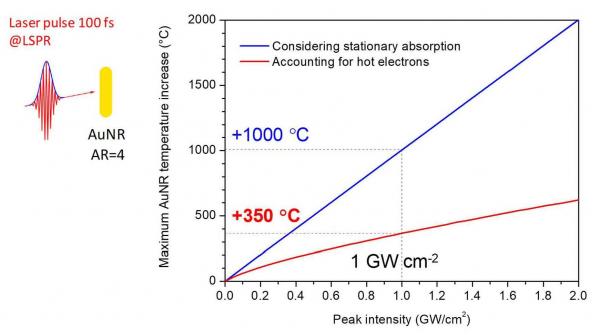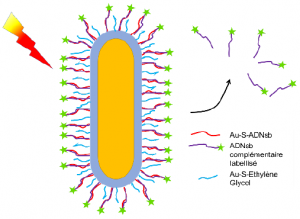Photothermal conversion in metal nanoparticles and applications
P.I.: Bruno Palpant
Noble metal nanoparticles are efficient converters of light into heat at small scales when lightened at their localized surface plasmon resonance.
One can then envisage thermoresponsive materials or devices whose functionality is only activated and controlled by light.
As well known by heat engineers for decades, the shorter the heating time by the source, the smaller the spatial thermal range around is. Hence, in thermoplasmonics, it has been demonstrated that by using ultrashort laser pulses the heating of the medium surrounding the nanoparticles is more confined than with longer pulses or with continuous light.
Besides, at fixed irradiation mean power density, the temperature reached by the nanoparticles and their close vicinity is much larger, though lasting only for about a few picoseconds for each pulse.
In the team, we study the fundamental mechanisms of plasmonic photothermal conversion and heat release and exploit them through different projects devoted to functional materials or biomedical developments.
Video focus:
Gold nanoparticles for health. A video realized by Massinissa Beldjenna, MSc student of the team (video in French here)
Selected achievements
-
The ultrafast photothermal conversion is strongly influenced by hot electrons
While the temperature reached by NPs shined with pulsed light is usually evaluated in the literature based on their stationary optical properties, we have shown that their actual temperature is highly influenced by the effects of hot electrons.
Maximum temperature increase reached by a gold nanorod (aspect ratio = 4) after shining with a 100-fs laser pulse tuned to its longitudinal plasmon resonance as a function of the pulse peak intensity. Comparison of the temperature estimated from the stationary optical absorption cross section of the NP (blue) and after accounting for the effect of the generation of hot electrons by the light pulse (red).
-
Biomedical applications of plasmonic photothermal conversion
A consortium gathering our team, chemists, biologists and oncologists has demonstrated the ability of multifunctional plasmonic nanoparticles irradiated by ultrashort laser pulses to address the treatment of HER2-overexpressing metastatic breast cancers resistant to anti-HER2 therapies. Besides, we have shown that using pulsed light rather than continuous light, yet with the same wavelength, power and irradiation time, leads to a better effect on cancer cell destruction.
Ongoing projects
-
Light-induced delivery of therapeutic genetic material with gold nano-objects
Most dysfunctions in cancer cells result from the expression of mutated genes or deregulated genes that overexpress proteins. Gene therapy can revolutionize cancer treatment by turning off a defective gene using an oligonucleotide (DNA, RNA). In addition, when illumination of gold nanoparticles is achieved by ultrashort laser pulses, the photo-induced heating is brief, intense and very confined around the nano-objects. Our project offers to improve the efficiency of DNA delivery in biological cells and its quantitative control by grafting oligonucleotides onto gold nanorods coated with silica and then triggering the delivery by photothermal effect induced by laser pulses. This project gathering our team, chemists and biologists is supported by the Institut d’Alembert in ENS Paris-Saclay.
-
Design and study of photothermally-triggered materials
Based on the nanoscale photothermal conversion we study hybrid materials in order to drive different functionalities by optical means. Plasmonic nano-objects are for instance combined with thermosensitive polymers or thermochromic oxides.
Partners
S. Boujday, LRS, Sorbonne Univ. (Paris); B. Heddi & C. Nogues, LBPA, ENS Paris-Saclay; M. Chaker, INRS, Montréal (Québec, Canada); Y. Tran & C. Fretigny, SIMM, ESPCI (Paris); N. Hadilou, Univ. of Bonab & Sharif Univ. of Technology (Tehran); M. Rashidi-Huyeh, Univ. Sistan&Baluchestan, Iran
Related publications
-
Coating gold nanorods with silica prevents the generation of reactive oxygen species under laser light irradiation for safe biomedical applications, Sarra Mitiche, Syrine Gueffrache, Sylvie Marguet, Jean-Frédéric Audibert, Robert Bernard Pansu, and Bruno Palpant, Journal of Materials Chemistry B. 10, 589-597 (2022). DOI: https://doi.org/10.1039/D1TB02207E.
-
Influence of the sequestration effect of CTAB on the bio-functionalization of gold nanorods, Henryk J. Laszewski, Bruno Palpant, Malcolm Buckle, and Claude Nogues, ACS Appl. Bio Mater. 4, 4753-4759 (2021). DOI: : https://doi.org/10.1021/acsabm.0c01522.
-
The effect of gold nanoparticle capping agents on 1O2 detection by singlet oxygen sensor green, Sarra Mitiche, Jean-Frédéric Audibert, Sylvie Marguet, Bruno Palpant, and Robert Bernard Pansu, Journal of Photochemistry and photobiology A: Chemistry 410, 113170 (2021). DOI: 10.1016/j.jphotochem.2021.113170
-
An optimal architecture of magneto-plasmonic core-shell nanoparticles for potential photothermal applications, Naby Hadilou, Somayeh Souri, Ali Navid Khoshgenab, Rasoul Sadighi Bonabi, Abbas Anvarib and Bruno Palpant, Phys. Chem. Chem. Phys 22, 14318-14328 (2020). DOI: 10.1039/D0CP01509A
-
Pulsed-laser irradiation of multifunctional gold nanoshells to overcome trastuzumab resistance in HER2-overexpressing breast cancer, Toni Nunes, Thomas Pons, Xue Hou, Khanh Van Do, Benoît Caron, Marthe Rigal, Mélanie Di Benedetto, Bruno Palpant, Christophe Leboeuf, Anne Janin, Guilhem Bousquet, Journal of Experimental & Clinical Cancer Research 38, 306 (2019). DOI: 10.1186/s13046-019-1305-x
-
Raspberry-like small multicore gold nanostructures for efficient photothermal conversion in the first and second near-infrared windows, Anouchka Plan Sangnier, Romain Aufaure, Soshan Cheong, Laurence Motte, Bruno Palpant, Richard D. Tilley, Erwann Guenin, Claire Wilhelm,Yoann Lalatonne, Chem. Comm. 55, 4055-4058 (2019). DOI: 10.1039/C8CC09476D
-
Photothermal properties of gold nanoparticles, B. Palpant, in “Gold nanoparticles for physics, biology and chemistry”, pp. 87–130, Eds. C. Louis and O. Pluchery (World Scientific, 2017).
-
Enhancement of the thermo-optical response of silver nanoparticles due to surface plasmon resonance, Sakineh Hashemi Zadeh, Majid Rashidi-Huyeh, Bruno Palpant, J. Appl. Phys. 122, 163108 (2017). DOI : 10.1063/1.4997276
-
A detailed microscopic study of the heat transfer at a water gold interface coated with a polymer, J. Soussi, S. Volz, B. Palpant, and Y. Chalopin, Appl. Phys. Lett. 106, 093113 (2015). DOI: 10.1063/1.4913905.
-
In vivo uptake and cellular distribution of gold nanoshells in a preclinical model of xenografted human renal cancer, M. Pannerec-Varna, P. Ratajczak, G. Bousquet, I. Ferreira, C. Leboeuf, R. Boisgard, G. Gapihan, B. Palpant, E. Bossy, E. Doris, J. Poupon, E. Fort, A. Janin, Gold Bulletin 46, 257-265 (2013). DOI: 10.1007/s13404-013-0115-8.
-
Gold nanoparticle assemblies: Interplay between thermal effects and optical response, Y. Guillet, M. Rashidi-Huyeh, D. Prot, and B. Palpant, Gold Bull. 41 (4), 341–348 (2008).
-
Non-Fourier heat transport in metal-dielectric core-shell nanoparticles under ultrafast laser pulse excitation, M. Rashidi-Huyeh, S. Volz and B. Palpant, Phys. Rev. B 78, 125408 (2008).
-
Gold nanoparticle assemblies: Thermal behaviour under optical excitation, B. Palpant, Y. Guillet, M. Rashidi-Huyeh, and D. Prot, Gold Bull. 41 (2), 105–115 (2008).
-
Highly dispersive thermo-optical properties of gold nanoparticles, B. Palpant, M. Rashidi-Huyeh, B. Gallas, S. Chenot, and S. Fisson, Appl. Phys. Lett. 90 (22), 223105 (2007).
-
Counterintuitive thermo-optical response of metal-dielectric nanocomposite materials as a result of local electromagnetic field enhancement, M. Rashidi-Huyeh and B. Palpant, Phys. Rev. B 74, 075405 (8 pages) (2006).
-
Thermal response of nanocomposite materials under pulsed laser excitation, M. Rashidi-Huyeh and B. Palpant, J. Appl. Phys. 96 (8), 4475–4482 (2004).




